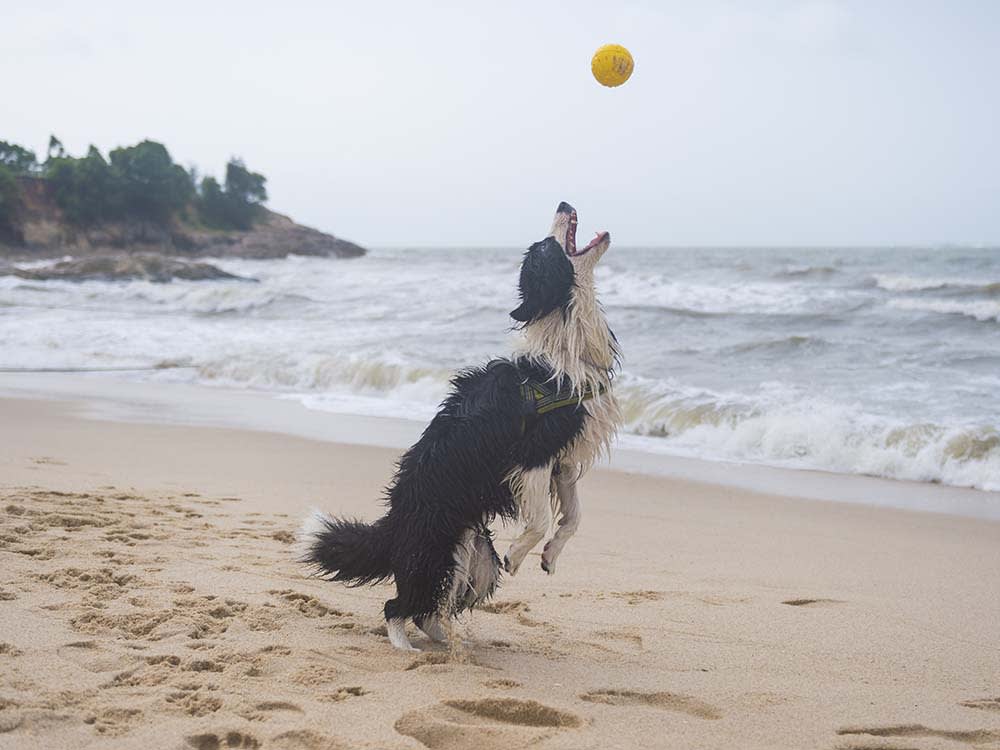How to Keep Your Dog Safe At the Beach
Five tips to help your pup have fun in the sun – safely
Beach days are even better when you can bring your dog. But as much fun as it is to enjoy the sand and sun with your pup, it’s also important to keep safety in mind. The beach can pose hazards for dogs like getting sick from drinking salt water and even sunburn. Here’s how to help your dog have fun in the sun – safely.
How to prepare your dog for a day at the beach
Are dogs allowed at the beach?
Before you head out to the beach, make sure that your dog is allowed to join you. Some beaches may have restrictions on where dogs can go, while others may not be ideal due to size or terrain. To determine if dogs are allowed, check out your chosen beach’s dog-friendly status on The Beach Guideopens in new tab. The beach’s local council will also have information on their website. And be sure to clean up after your dog at the beach, just as you would anywhere else.
Is it safe for dogs to swim in the ocean?
In general, it is safe for dogs to swim in the ocean – it can be great exercise for them. But before heading out to the water, take note of a few precautions:
Check the water conditions. Your dog may be a strong swimmer, but large rolling waves can still be very dangerous. Before you take your dog to the beach, it’s important to check the water conditions. Some beaches may have rip currents or other hazards that could be dangerous for dogs. In these conditions, you might want to keep your dog on a lead so that they can’t go out too far.
Beware of other animals and wildlife. Scan both the water and sand for crabs and other marine life, which can be dangerous for dogs. Be aware of sea lice that can cause itchy red bumps on dogs. Prevent your pup from rolling in or eating anything that could make them sick. Be especially mindful of areas that have a high volume of jellyfishopens in new tab. Another tip: discourage your dog from eating sand when playing fetch at the beach. Too much sand ingested can create an impaction in their intestine causing their intestinal tract to close up.
Monitor salt water ingestion. Your dog may want to lap up the salty ocean water if they’re thirsty, but the salt, bacteria and parasites in the water can make them sick. While at the beach, dogs can get dehydrated quickly in the sun, so it is imperative that you prevent your dog from drinking salt water by providing them with plenty of fresh water. Drinking salt water can lead to saltwater poisoning, vomiting after swimming and ‘beach diarrhoea’. A few gulps of salt water won’t harm your dog, but watch for vomiting and early neurological signs of salt poisoning, such as dullness and depression. Remember, it is also possible for your pup to have too much water, be careful of water intoxication.
Bring a dog life jacket
While many dogs have a natural instinct to swim, it’s important to remember that not all dogs can swim. Some breeds are also physically better suited to swimming (hello Retrievers), whereas others might be frightened or have difficulty swimming. Dogs who enjoy boating or swimming should always wear a life jacket. Make sure that the life jacket fits properly and give your dog time to get used to having it on while swimming before going deeper into the water.
Protect paws and ears
Salt can be irritating to paws and skin, too. Rinse salt water and sand from your dog’s coat after swimming. Always clean and dry ears after a swim. Water that remains in ears, especially from the ocean, can result in a bacterial ear infection.
Is it too hot for my dog at the beach?
Dogs regulate their body temperature primarily by panting, which is not as efficient as sweating, this makes them more susceptible to heat-related dangers. Limit your dog’s exposure during peak sun hours (between 10am and 3pm) and apply doggy sunscreenopens in new tab 30 minutes before going outside. Here are a few other ways to ensure your pup is not too hot at the beach.
Protect your dog from the sun
Despite all that fur, it’s important to be aware of the risks of sunburn in your pet. Dogs can get sunburnt, too – their noses, bellies and areas with particularly thin or light-coloured fur are susceptible to the sun’s hot rays – so it’s important to keep them protected with the shade of a beach umbrella, UV protective shirt and sunscreen.
Use dog-specific sunscreen made with ingredients repellent to dogs to keep them from licking it. If you are unsure that your sunscreen is pet-safe, double-check the label to make sure it doesn’t contain zinc oxide (Desitin) or salicylates (aspirin); these can be toxic if licked off and ingested in large amounts. Stomach irritation can also occur if excessive amounts are ingested, so be careful about putting too much on in an area where they can lick it. If you have a breed that is predisposed to eye problems, such as a Pug or Shepherd, doggy goggles are a good choice for eye protection.
Protect their paws from hot sand
Hot sand (and pavement) can easily exceed comfortable temperatures for delicate paw pads leading to blisters. Try booties. If the sand is too hot for you to walk barefoot, then it’s too hot for your pup’s paw pads. Save your beach trip for a cooler day, or go in the early morning or late evening to avoid the heat.
Protect your pup from the heat
Running on the sand is strenuous exercise, and this can easily lead to heat-stroke in dogs. A dog that is out of shape can also easily pull a tendon or ligament, so keep checking your dog’s activity. And never, ever leave your dog unattended in your vehicle in the summer months – even while you’re loading and unloading your car at the beach. Heat-stroke and death can occur within minutes even in warm temperatures.








